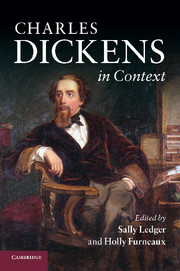Book contents
- Frontmatter
- Contents
- List of illustrations
- Notes on contributors
- Preface
- Notes on references
- PART I LIFE AND AFTERLIFE
- PART II SOCIAL AND CULTURAL CONTEXTS
- 12 Popular culture
- 13 The rise of celebrity culture
- 14 The newspaper and periodical market
- 15 Authorship and the professional writer
- 16 The theatre
- 17 Melodrama
- 18 The Bildungsroman
- 19 Visual culture
- 20 The historical novel
- 21 The illustrated novel
- 22 Christmas
- 23 Childhood
- 24 Work
- 25 Europe
- 26 The Victorians and America
- 27 Educating the Victorians
- 28 London
- 29 Politics
- 30 Political economy
- 31 The aristocracy
- 32 The middle classes
- 33 Urban migration and mobility
- 34 Financial markets and the banking system
- 35 Empires and colonies
- 36 Race
- 37 Crime
- 38 The law
- 39 Religion
- 40 Science
- 41 Transport
- 42 Illness, disease and social hygiene
- 43 Domesticity
- 44 Sexuality
- 45 Gender identities
- Further reading
- Index
45 - Gender identities
Published online by Cambridge University Press: 05 August 2012
- Frontmatter
- Contents
- List of illustrations
- Notes on contributors
- Preface
- Notes on references
- PART I LIFE AND AFTERLIFE
- PART II SOCIAL AND CULTURAL CONTEXTS
- 12 Popular culture
- 13 The rise of celebrity culture
- 14 The newspaper and periodical market
- 15 Authorship and the professional writer
- 16 The theatre
- 17 Melodrama
- 18 The Bildungsroman
- 19 Visual culture
- 20 The historical novel
- 21 The illustrated novel
- 22 Christmas
- 23 Childhood
- 24 Work
- 25 Europe
- 26 The Victorians and America
- 27 Educating the Victorians
- 28 London
- 29 Politics
- 30 Political economy
- 31 The aristocracy
- 32 The middle classes
- 33 Urban migration and mobility
- 34 Financial markets and the banking system
- 35 Empires and colonies
- 36 Race
- 37 Crime
- 38 The law
- 39 Religion
- 40 Science
- 41 Transport
- 42 Illness, disease and social hygiene
- 43 Domesticity
- 44 Sexuality
- 45 Gender identities
- Further reading
- Index
Summary
‘God created men and women different – then let them remain each in their own position’, declared Queen Victoria in 1870, the year of Dickens's death. Her comment invokes a binary opposition based upon sex that was widely used to prescribe the roles of men and women throughout the nineteenth century. The separation of workplace and home associated with the development of industrial capitalism, combined with assumptions about the biological differences of sex, led to the formation of gender identities defined by the so-called doctrine of ‘separate spheres’. Women, assumed to be innately maternal, passive and emotional, had their duties circumscribed by the home according to the dominant middle-class ideology of domesticity. Men, assumed to be strong, active, competitive and possessing an innate energy requiring manly self-discipline for its management, were identified as industrious breadwinners for the domestic establishment, which was superintended by their womanly helpmeet. The ideal was one of gender complementarity, and as Victoria's declaration suggests, it was buttressed by religion.
However, these ostensibly ‘natural’ differences determining gender were at the same time contradicted by discrepancies of class. Sequestration in the home was not an option for most working-class women, for example, and the ideal of the domestic angel was thus never as inclusive as its ideological dominance throughout the period might now suggest. Prevailing gender identities were constructed to suit the circumstances of the middle classes, but they were questioned on a number of fronts.
- Type
- Chapter
- Information
- Charles Dickens in Context , pp. 365 - 372Publisher: Cambridge University PressPrint publication year: 2011
- 1
- Cited by



